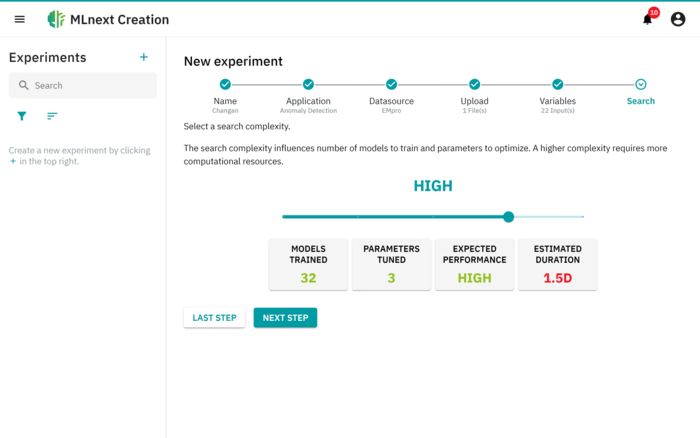Anomaly detection in the press shop of Changan Automobile When anomaly detection is used in press shops, problems can be identified at an early stage and proactive maintenance measures can be initiated. This helps to minimize downtimes and ensure product quality.

Customer profile
Changan Automobile
Changan Automobile Co, Ltd. is a Chinese automobile manufacturer headquartered in Jiangbei, Chongqing, China. CHANGAN Automobile is one of the four major Chinese automobile groups, with 40 years of automobile manufacturing experience. The company has 12 manufacturing bases and 22 plants worldwide.
The challenge

Efficient and resource-saving production
Automobile groups are under considerable pressure due to global competition, and are therefore always looking for ways to produce more efficiently. At the same time, automobile manufacturers are regarded as innovation drivers that lead the way for other industries. As a result, they face considerable social and political expectations regarding the creation of net zero factories in the context of the All Electric Society. The production process of a car begins with the pressing of the automotive parts. To do this, metal plates are pressed into special molds to produce the various parts of a vehicle. The parts are then turned into a ready-to-drive car in subsequent steps. The pressing process is therefore a decisive and energy-intensive step in the value chain of an automobile manufacturer. On the one hand, the process lays the foundations for the quality of the end product; on the other hand, failures and delays have far-reaching consequences for the entire flow of production and therefore the manufacturing costs of the vehicle.
The solution

With the framework and the Execution and Creation software tools, the MLnext portfolio offers the right machine learning solution that can be downloaded directly from the PLCnext Store
Transformation of existing factories into completely digitalized production facilities with machine learning
In view of the importance of the pressing process, Changan Automobile, one of the four major automobile manufacturers in China, researched a solution for anomaly detection on electric motors in its press shop. With Digital Factory now, Phoenix Contact offers a comprehensive range of products, solutions, concepts, and services for the digitalization of brownfield and greenfield factories, which can be used to create resource-saving and competitive digitalized production facilities. At the heart of the portfolio is MLnext, which consists of the MLnext Creation and MLnext Execution software solutions. MLnext facilitates the simple and effective use of machine learning (ML) in the Digital Factory. By using anomaly detection, Changan can now identify potential problems on motors at an early stage and take proactive action, thereby minimizing downtimes and ensuring product quality.

The open, modular structure enables OT, IT, and the cloud to be connected flexibly and without restrictions
Central acquisition of all motor data and storage in a database
The first and most important step of any machine learning project is the creation of a database. At Changan, the data was acquired for each press shop from two production lines, each with four presses and installed electric motors. This is where another product from the Digital Factory now portfolio is used: the IIoT framework. This involves a scalable, open, and flexible interface between OT (operational technology, production level) and IT (information technology). Data from the various sensors installed in the heterogeneous OT world can be collected via IN connectors for transmission protocols, such as PROFINET, MQTT, and Modbus. This data can then be stored on a persistent basis in a database using OUT connectors – e.g., MySQL or InfluxDB – or stored in the cloud – e.g., Proficloud.io, AWS, or Azure. In this way, the data is available in a comparable form at all times on all levels.
Changan uses an energy measuring device from the EMpro product family from Phoenix Contact to record the electrical parameters of a motor. The current consumption and the power of the motor, for example, are recorded and forwarded via a Modbus/TCP interface. A combined sensor also measures the temperature and vibrations and communicates the values via PROFINET IO-Link. The IIoT framework, which runs on an EPC 1522 series edge PC, is thus able to collect the data of all motors centrally and archive it in a database. The first database was available after one month.

The MLnext Creation interface is intuitive and uncluttered, so that machine learning can be implemented even without programming or specialist knowledge
Simple training of an ML model without programming knowledge
This database was used to generate the first ML model. The MLnext Creation software tool provides an intuitive user interface that can be used to train an ML model without any programming knowledge or statistical knowledge. The user is guided through the process step by step. In the Changan project, the recorded data was imported into MLnext Creation and the “Anomaly Detection” application was selected. Finally, the complexity for the hyperparameter search was selected. This determines how many different models are trained and compared with each other until the optimum model is found. The available computing time and computing power prove to be crucial here. All further steps take place in the background, e.g., preprocessing the data.
The model created by MLnext Creation is a neural network in the form of an autoencoder. Its purpose is to compress the input data and reduce it to the most important features in order to then reconstruct it from this compressed representation. In the context of anomaly detection, the autoencoder is trained with the normal operating data of the motors. If an abnormality is found in the input data after training, this cannot be fully reconstructed by the autoencoder. This results in significant deviations between the input data and the restored data, which means that anomalies can be identified.

The Grafana visualization software can be used to create target group-specific dashboards that provide an overview of the most important information
Target group-specific creation of modifiable dashboards
In the next step, the trained model is used in the production environment. For this, MLnext Execution offers a fully configurable pipeline that covers the entire process from data acquisition through preprocessing and inference with the model to storing events. The advantage of MLnext Execution is that no programming knowledge is required and everything can be set in a configuration file. In the Changan project, MLnext Execution is run on the same EPC 1522 edge PC that the IIoT framework is running on. This allows for seamless integration into the existing infrastructure. The data recorded by the motors is loaded from the database almost in real time and undergoes the same preprocessing as during model training. The model then analyzes the data for anomalies and archives the result, i.e., the time period and the trigger, back in the database.
The user-friendly Grafana tool is used to visualize the data and results of the model. Grafana can be used to create target group-specific dashboards that provide an overview of the operating data of the motors and the detected anomalies. In addition, Grafana opens up the possibility that Changan will be able to make modifications to the dashboards independently later on. In addition, alerts can be set up for the identified anomalies, which make maintenance personnel aware of potential problems.
Advantages
- Holistic approach: collecting, storing, and evaluating data
- Increased efficiency: reduced downtimes and less maintenance work through data analysis
- No ML expertise required: MLnext facilitates the use of machine learning without specialist knowledge, which simplifies accessibility and use in production
- Adaptability: the solutions can be flexibly applied to various applications with time series data so that they can be used in different production environments
Summary

Using MLnext for anomaly detection in the press shops of Changan Automobile shows how potential problems can be identified at an early stage, thereby minimizing downtimes and increasing competitiveness. The iterative process of machine learning also provides the option of continuously improving the model by evaluating the detected anomalies, thereby increasing the precision of anomaly detection.



